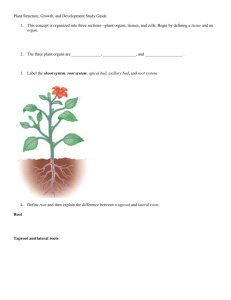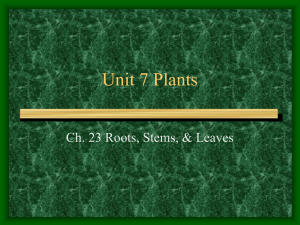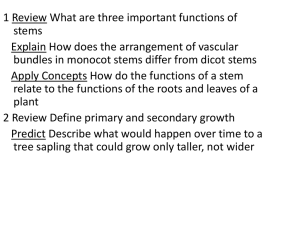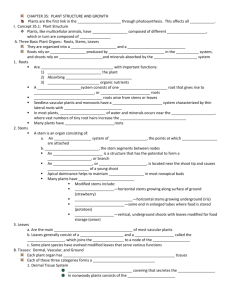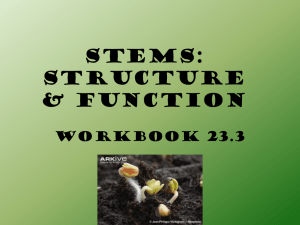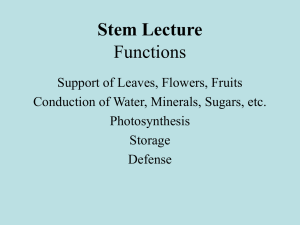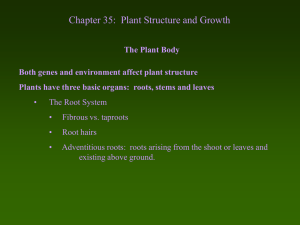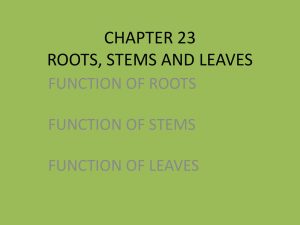Chapter 29
advertisement
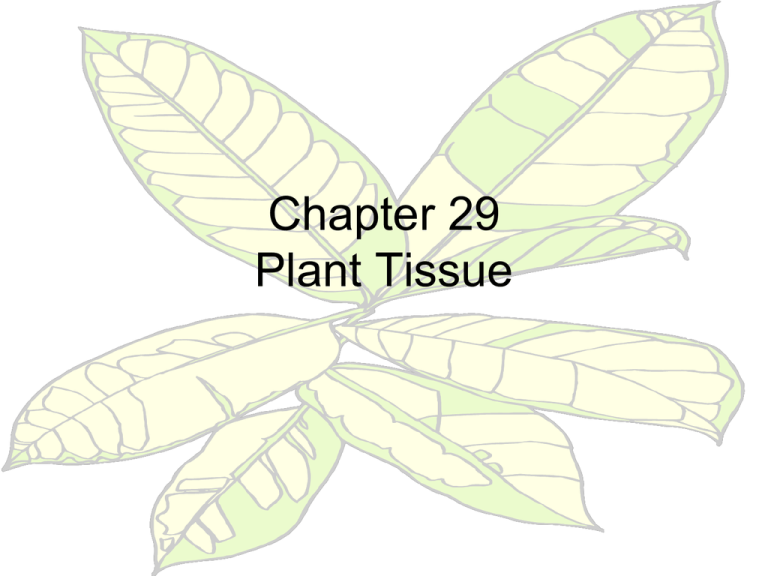
Chapter 29 Plant Tissue Overview of the Plant Body • Although no one species of the 295,000 species of plants can be considered typical, the focus here is on angiosperms Shoots and Roots (Figure 29.2) • Shoots consist of stems, leaves, and flowers (reproductive structures) – Water, minerals, and organic substances are transported – Stems are frameworks for upright growth and to display flowers – Parts of the system store food. Continue… • Root system absorbs water and minerals from soil and conducts them upward • Root store food • Anchor and support the plant Three plant tissue system • 1- Ground Tissue: makes up the bulk of the plant body (food and water storage) • 2- Vascular tissue system: contains two kinds of conducting tissues that distribute water and solutes through the plant body. • 3- Dermal Tissue system: covers and protects the plant’s surfaces. Where Do Plant Tissues Originate? • Meristems are localized regions of selfperpetuating, embryonic cells. • Two kinds of meristems – 1- Apical meristems: at tips of roots and stems is responsible for growth and elongation • Growth originating at the root and shoot tips is labeled primary growth Continue… • Lateral meristem: are responsible for the increase in diameter of older roots and stems. – Vascular Cambium and cork cambium are two kinds of lateral meristems – These are responsible for secondary growth which adds to wood parts of the trees. Types of Plant Tissues • Simple Tissues: – 1- Parenchyma makes up most of the soft, moist primary growth of plants • Thin walled pliable cells stay alive and retain the capacity to divide • Various types of participate in photosynthesis (mesophyll), storage, secretion, and other tasks. – 2. Collenchyma: cells are thickened and help strengthen the palnt (e.g. strings of celery) • It commonly arranged at strands or cylinders beneath the dermal tissue of stems and stalks • The primary cells walls of collenchyma become thickened with cellulose and pectin at maturity. – 3. Sclerenchyma: cells provide mechanical support and protection for mature plants • Secondary walls are thick and often impregnated with lignin, which strengths and waterproofs the cell walls • Form fibers such as hemp and flax – Sclereids form strong coats around seeds as in a peach pit Complex Tissues • Vascular tissues function in the distribution of substances throughout the plant – Xylem uses two kinds of cells (dead at maturity) to conduct water and minerals absorbed from the soil • Vessel members: are shorter cells joined end to end to form a vessel with perforation plates at the end of each member • Tracheids are long cells with tapered, overlapping ends Continue… – Phloem: transports sugar and other solutes throughout the plant body. • Phloem contains living conducting cells called sieve tube members which bear clusters of pores in the walls through which the cytoplasm of adjacent cells is connected • Companion cells: adjacent to the sieve tubes members, help to load sugars produced in leaves and unload them in storage and growth regions Continue… • Dermal Tissue System: called the epidermis covers all primary plant parts – Waxy Cuticle covers the external surfaces of the plant to restrict water loss and resist microbial attack. – Stomata openings between pairs of guard cells permit water and gaseous exchange with the air – Periderm replaces the epidermis when roots and stems increase in diameter and become woody. Monocots and Dicots • Through the rest of chapter we will be talking about monocots and dicots • Moncots have one cotelydons (seed leaf) and Dicots have two cotelydons (seed leaf) • Common monocots include: grasses, lilies, irises and palms. • Common dicots include: trees and shrubs Primary Structure of Shoots • Leaves develop from leaf primordia along the apical meristems of stems – A node is the point where a leaf or leaves attach to the stems – Internode is the region on the stem between the two nodes. Continue… • Buds develop in the leaf axils (the upper angle where leaves attach to the stem) – A bud is underdeveloped shoot of mostly meristematic tissue covered by modified leaves (bud scales) – Buds give rise to stems, leaves, and flowers Internal Structure of Stems • A vascular bundle is a multistranded cord of primary xylem and phloem running lengthwise through the ground tissue of shoots. Similarities and Differences Among Leaves • Leaves are metabolic factories equipped with photosynthetic cells. • Deciduous trees drop their leaves as winter approaches – Evergreen retain their leaves • Leaves vary enormously in shape, size, texture, and surface features. – Monocots leaves tend to have a flat surface – like a knife blade, the base of which encircles and sheaths the stems – Dicots leaves have broad blade attached by a petiole to the stem; the blade may be lobed or composed of leaflets – Simple leaves: undivided leaves • Oak – Compound leaves: divided leaflets • Locust • Leaves represent a large surface area that is exposed to sunlight and carbon dioxide Leaf Fine Structure • Epidermis covers every leaf surface exposed to air (waxy layer) – A cuticle layer minimizes water loss. – Stomata are located mostly on the lower epidermis Continue… • Mesophyll consisting of photosynthetic parenchyma cells extends throughout the interior of the leaf – Air spaces, which connect to the stomata, participate in gaseous exchange – Palisade mesophyll cells lies closer to the epidermis and are columnar in shape compared to the spongy mesophyll below them • Leaf veins are vascular bundles of xylem and phloem that form a network for movement of water , solutes, and photosynthetic products Primary Structure of Roots • Taproots and Fibrous Root Systems – In most dicots, the primary root emerges from the seedling, increases in diameter, and grows downward. • Lateral roots emerge sideways along its length • Primary root plus lateral roots form from the taproot system Continue – Monocots: the taproot is replaced by adventitious roots that arise from the stem • The roots and their branching form a fibrous root system • Fibrous roots do not penetrate as deeply. Internal Structure of Roots • Cells in the apical meristem divide and then differentiate into root epidermis, ground tissues, and vascular tissues behind the meristematic region – The root cap protects the apical meristem and pushes through the soil – Cells are torn loose as the root grows Continue… • Protoderm gives rise to the root epidermis with its extensions called root hairs for the outer absorptive interface with the environment • Vascular tissues form a vascular cylinder arranged as a central column – The column is surrounded by root cortex (ground tissue), which has abundant air spaces – The endodermis- the innermost layer of the cortex –surrounds the vascular cylinder and helps control water movement into it Woody and Nonwoody Plants • Seasonal growth cycles proceed from germination, to seed formation to death. – Annuals complete life cycle in one season, they are nonwoody , or herbaceous plants such as corn. – Biennials such as carrots, live two seasons: vegetative growth first , flower and seed formation second season • Perennials live many years and have secondary growth (roses, grape vines, and apple trees) • Woody plants such as dicots and gymnosperms show secondary growth by producing large amounts of secondary xylem Vascular Cambium • Vascular Cambium is a cylinderlike lateral meristem. – It produces a secondary xylem on its inner face and secondary pholem on its outer. – The secondary growth displace the cells of the vascular cambium toward the stem surface • Secondary xylem and phloem form at the vascular cambium of the roots Formation of Bark • In response to rupture of the outer cortex (by girth expansion), cork cambium produces the periderm – a corky replacement of the epidermis – Periderm and secondary pholoem constitute of bark – Periderm consist of cork, secondary cortex, and cork cambium • Lenticels are small channels through the corky surface of bark that allow for exchange of gases Heartwood and Sapwood • Heartwood lies at the center of older stems and roots. – It depository for resins, oils, gums and tannins – It makes tree strong and able to defy gravity/ • Sapwood is secondary growth located between heartwood and the vascular cambium – Wet, pale in color and is not strong – Rich in the sugar-rich fluid of the phloem Early Wood, Late Wood, and Tree Rings • In regions with cool winters or dry spells, the vascular cambium is inactive during part of the year – Early wood (start of the growing season) contains xylem with large diameters and thin walls – Late wood contains xylem with small diameter and thick walls – Growth rings appear as alternating light bands or early wood and dark bands of late wood Continue… • Hardwood: (OAK) has vessels, tracheids, and fibers in its xylem • Softwood (CONIFERS) have no vessels or fibers Limits to Secondary Growth • Some trees live in habitats too harsh and remote for most invaders • Most trees use a strategy of compartmentalization to wall off invaders, building a fortress of thickened cells walls around wounds or deploying toxic compounds •The End
